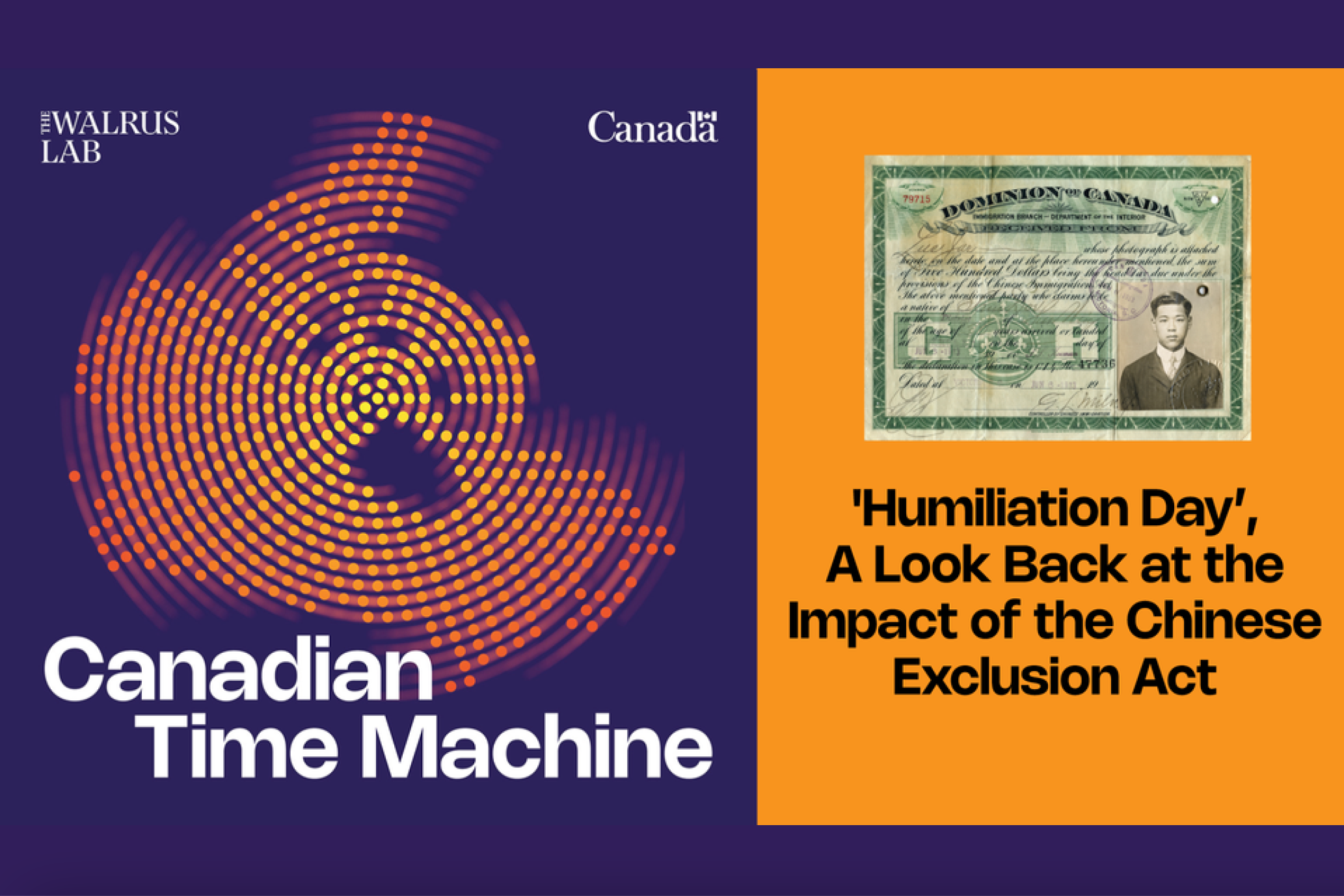Listen to the episode:
Angela Misri: Gillian Der will never forget the moment she saw her family’s immigration records.
Gillian Der: I was interning at the Burnaby Village Museum for like a summer project. And so we were looking at these histories of Chinese Canadians in Burnaby. And I remember the head curator was like, “oh, well, we have these records.” And it was just this Excel file that was just sitting on the computer. I can really visualize myself in the curatorial office just like ctrl f looking up these names and finding it. Maybe it’s just because I haven’t lived it and I’ve only like heard the stories of it, but I think it was a moment of like, “oh wow, that was… that really did happen. And that really was my family.”
Angela Misri: Welcome to Season 2 of Canadian Time Machine, a podcast that unpacks key milestones in our country’s history. This podcast receives funding from the Government of Canada and is created by The Walrus Lab. I’m Angela Misri. Today’s episode is all about the 100th anniversary of the adoption of the Chinese Exclusion Act…and before we get into the intricacies of a law that impacted thousands of people, we’d like to hear more about the intergenerational impact of this legislation on Gillian Der. Her roots in Canada go back at least four generations, and she grew up knowing bits and pieces of the family story.
Gillian Der: Growing up, there must have been an anniversary of the last spike or the handing of the last spike over to Chinese rail workers. I remember my mom giving us, both me and my sister, a little pin and to commemorate that and talking about what the railway meant and talking about what the head tax meant.
Angela Misri: Gillian has at least one relative who is among the thousands of Chinese men who built the Canadian Pacific Railway in the 1880s for a fraction of the wages paid to other laborers and with little recognition. They were often tasked with the most dangerous jobs, and by the time the railroad was completed, at least several hundred Chinese workers had died. Immediately after the railroad’s completion, the Canadian government imposed the head tax, a fee that was exclusively applied to most people arriving from China, in an effort to discourage immigration. The head tax quickly climbed from $50 to $500, often causing immense economic hardships. Soon enough, though, the government found that the head tax was not “enough” to dissuade immigration, and on July 1st, 1923, they passed the Chinese Immigration Act, also known as The Exclusion Act. The law barred Chinese immigrants from entering for nearly 25 years, with very few exceptions…and many came to refer to the date the law was passed as “Humiliation Day”. The blatantly racist legislation had a profound effect on Chinese Canadian families all across the country. While the law was repealed in 1947, its effects continue to affect families to this day, including Gillian’s.
Gillian Der: There are, like, sneaky whispers in my family about, like, “oh, well, this daughter was allowed to come over and he somehow got this person to join him, but forgot about us in the village.” And I think a lot of that has meant that there is some resentment between siblings. I do have like two great aunts in Vancouver, but I’ve only met with one of their daughters, um, despite my family being here. I don’t know them. And that’s some kind of historical rift that I know happened because of our immigration history and the barriers to immigration. And just like from a very human level, the horror and the trauma of like not being able to be picked by your family. Consistently.
Angela Misri: The trauma of the legislation was profound not just on the family members who were left behind in China, but also on the men who were left alone in Canada, without the ability to bring over any family to join them. Community members and historians often refer to these men as “the bachelors.” Some of them lived very lonely lives. Here’s Keith Lock, a member of the Chinese Canadian community, remembering some of the bachelors he met growing up. Mr. Lock was interviewed for a documentary currently being featured at the Chinese Canadian Museum in Vancouver as part of their exhibit commemorating the Exclusion Act.
Keith Lock: Well, they were always kind, they were always honest. When I would encounter them, if they would talk to me, it would be really a special thing for them because they didn’t have families, they didn’t have children, they didn’t have grandchildren, they had very few opportunities to talk to kids. They would sometimes give me advice, or tell your father to teach you this. They were kind of like uncles, they would, they would take that role.
Angela Misri: Here to tell us more about these bachelors, and the thousands of other individuals and families impacted by the Exclusion Act, is Dr. Melissa Lee. She’s the CEO of the Chinese Canadian Museum, and she joins us from Vancouver, B. C. Welcome, Dr. Lee.
Dr. Melissa Lee: Thank you so much, Angela. It’s great to be here.
Angela Misri: I understand that the Chinese Canadian Museum opened its doors to the public on July 1st, 2023, which is the 100th anniversary of the adoption of the Chinese Exclusion Act. Do you think there’s a reason that the act was passed on what was then called “Dominion Day”, nowadays referred to as Canada Day?
Dr. Melissa Lee: I think it is significant. Usually the national day of any country is a day of patriotism, it’s a day of nationalism. What we often do see is that there is a particular pride in being part of that country. And I think for the idea that the Chinese Exclusion Act, was passed on that day is just more really to gesture towards the kind of exclusion and the racism that Chinese Canadian communities were faced with a hundred years ago during that time. I think we do see those forms of conservative nationalism, even today, not only in Canada, but in the United States, where a forms of exclusions of particular cultures are seen as a kind of radical patriotism.
Angela Misri: That’s exactly what I was going to say is that this kind of radical patriotism is so weird to think about now as an Asian who lives in this country. I think the significance is there. The current exhibit at the museum is called “The Paper Trail to the 1923 Chinese Exclusion Act.” I understand that the exhibit features a vast quantity of identity documents collected from the time of the head tax through the years of the Exclusion Act. Can you tell us about the concept behind the current exhibit? Why did the curator choose to focus on the act of documentation?
Dr. Melissa Lee: So, Catherine Clement, the curator, spent over four years gathering these CI certificates. They’re called Certificates of Identity, specifically used to track Chinese Canadians during the Chinese Immigration Act. When the Chinese were excluded in 1923, those that already lived in Canada that were Chinese-Canadian, those that were born here, were forced to register. And they were forced to register through the government and given these certificates. And these certificates were really a form of exclusion. If you come to our exhibition and examine them closely, they say Department of Immigration and Colonization, and they also say– at the bottom — “this certificate does not establish legal status in Canada.” And these were Chinese-Canadians that were born here.
Angela Misri: Do you think you could describe these documents to us? Because I’m thinking that a lot of our audience would love to come and see these physically, but if they cannot, are we talking about something that looks like a passport? Is it a folded piece of paper? What do they look like?
Dr. Melissa Lee: It is a folded piece of paper because you were meant to carry them in your wallet or in your pocket. At any point, a police officer or any type of government official could ask you for it and you had to carry it on your person. One of our exhibition rooms, we have hundreds of them on the wall, on display, and many of the documents show children, they show babies. In particular, the CI-45. That particular number was given to those Chinese Canadians that were born in Canada. So a lot of them were babies. And also for a lot of them, it was, for a lot of us, it was the first time a picture was taken. So we have hundreds of these documents on the wall, and Catherine organized them in a line as well to really show the hundreds and hundreds of Chinese Canadians that lived here and were documented. Some of them have poppies. Uh, Catherine has placed poppies and flowers to show that they also served in the war. So even though there was a form of racism, there were many that Chinese Canadians that were patriotic in spite of the racism that was known for them in the country, and so they also served in the war. I think just to highlight one particular certificate that we have on display is Alexander Cumyow. He is the first Chinese Canadian born in Canada. And our mayor of Vancouver, Ken Sim, opened a satellite office in Chinatown. And the office is called Alexander Cumyow in honour of the first, uh, Chinese Canadian born in Canada.
Angela Misri: So, I understand that this level of documentation and exclusion applied not only to people trying to enter Canada from China, but as you say, also to the Chinese Canadians who were born on Canadian soil. Can you tell us more about the impact of this multi generational exclusion?
Dr. Melissa Lee: Yes, so there was many impacts that were felt from different generations. One impact, of course, was the separation of families. For many Chinese Canadians, when Chinese people immigrated here, the men would come first. Because, don’t forget, right before the Exclusion Act, there was the head tax. So the head tax at first was $50, and then it was raised to $100, and then finally it was raised to $500. The total amount collected in Canada from the head tax was 23 million Canadian dollars. In today’s dollars, it’s over a billion. So it would take everything from a family to be able to send one family member over to Canada to pay that head tax. And usually it was the man, because the thought process was that the man would come over to Canada first, work and make money either during the gold rush or the railway. And then slowly pay the head tax and send their family over. But because of the Exclusion Act, a lot of families were separated.So many of the men, they were called bachelors, even though some of them were not bachelors, did not see their wives or children for 24 years, when the children were already grown up. Another impact is those men that were single had no chance of getting married or making families. So they remained bachelors and there is a section in our exhibition where Catherine has really honored the bachelors of Chinatown where we feature the portraits of these men that were never able to have families never able to get married. And we have a documentary and in the documentary we interview kids. They were kids at the time but now they’re in their 60s and 70s and they talk about how, in that time, their parents would ask them to really be with the bachelors during the day, maybe take them to cafes or the bachelors would babysit. And it was a kind of way to honor those men that were never able to have their own children and to allow them to play with kids and have them as ad hoc family members because children at that time were so precious and so few.
Angela Misri: It does beg the question, if there were so many bachelors who came over to Canada, started working here, and then were not allowed to either have families here or bring their families from China, why did they keep coming?
Dr. Melissa Lee: I mean, I think that they, a lot of them were already here before 1923. But, you know, it was also kind of the thought that there would be a better life, uh, in Canada. Before the Exclusion Act, there was a way to kind of leave China and to search for what was called Gold Mountain at that time.
Angela Misri: So there are a lot of people whose documentation, as you say, is featured at the exhibit that we don’t know much about. But there are a few stories we do know a bit more about, like you described Won Alexander Cumyow. Can you tell us a little bit about, more about some individuals that are featured in the exhibit?
Dr. Melissa Lee: Yeah, so there’s actually, you know, every single card has a story and has a family member– generations attached to it. Just to speak generally at first, many, many people across Canada have been coming to the exhibition. Families from Toronto, from Halifax. from Newfoundland have been coming. Even from the United States, families from New York and San Francisco, because back then a lot of Chinese immigration was from the original Southern Chinese counties, the four counties and the immigration would go from Canada as well as from the United States. So we have several generations of visitors that come and they have never seen a picture of, uh, their ancestor. Part of the reason why they’ve never seen a picture of their ancestor or seen the certificate is because these records have been sealed for a hundred years. They’ve been sealed in the national archives of Canada in Ottawa, and it was really through the advocacy of the curator and her curatorial team that the National Archives agreed to unseal the records, and they unsealed the records in conjunction with our exhibition on July 1st this year. So, from now on, you can search for your ancestor and see the original photograph of where you are from. This was something that was denied to Chinese Canadians for a very, very long time.
Angela Misri: And when you talk about the government opening things up in conjunction with what you’re doing at this exhibit, in 2006, Stephen Harper’s government formally apologized to the Chinese Canadian community and all the families impacted by the head tax and by the Exclusion Act. They also offered reparations. But for many people, this apology and the money offered was not enough. Gillian Der, who we spoke with earlier in this episode, notes that her grandmother refused the government money. Listen to what she has to say about this.
Gillian Der: There’s so much power in her refusing it. In her being able to say on her own terms, this is done, and also to not let the government decide when it’s done, decide that this amount of money means that it’s done.
Angela Misri: Doctor Lee, what are your thoughts on Gillian’s reflections?
Dr. Melissa Lee: I mean, in many ways, she’s right. There’s future governments that come in, and they recognize the historical wrongs, and what they can do is apologize for previous governments and on behalf of Canada. And sometimes the money does not seem adequate. It seems inadequate for many different reasons. For trauma that Chinese Canadians, that other cultural ethnicities face through generations. But at the same time, what, what is enough? What can one do? For us at the Chinese Canadian Museum, we exist because of these formal apologies by governments. The Harper government apologized, the government of BC, the premier apologized, created a memorandum with the city of Vancouver, and committed to building a Chinese Canadian museum. And so this year, on the hundred year anniversary of the Chinese Exclusion Act, we opened and we are the first Chinese Canadian museum in Canada. And we exist possibly because of these historical wrongs and the apologies given by successive governments. So I think it is a reconciliation process on many levels. And I think that we have to look to a path forward that is more optimistic.
Angela Misri: Yeah. And I think I know part of the answer to this question, but what would you recommend to our listeners who want to support the Chinese Canadian community and continue to honor their histories?
Dr. Melissa Lee: I think there are many ways. Of course, it would be great if you come to visit us in Vancouver. We are in Vancouver Chinatown. We’re in the oldest building in Chinatown. We are part of a community that hopes to revitalize different Chinatown areas, not only in Vancouver, but in all the different provinces. We’re really committed to honoring and revitalizing these historical towns that house Chinese Canadian communities. I think also to learn about Chinese Canadian culture. Chinese Canadians have been here since 1788. And to really understand on a larger scale how diverse Canadian identity is. I think that there are many narratives about the building of Canada. We are one, Chinese Canadians, there are other diverse narratives of cultural communities that also help build Canada that perhaps have been invisible up until now, and it’s really important, I think, as an educator, as a teacher, as a researcher, or somebody who’s a student in life to learn.
Angela Misri: 100%. It’s not something I came across in high school or in junior high. So it’s, it’s definitely necessary and definitely needed. Thank you so much for your time, Dr. Lee.
Dr. Melissa Lee: Thank you so much for having me on, Angela. It’s been really a pleasure.
Angela Misri: Thank you for listening to Canadian Time Machine. This podcast receives funding from the Government of Canada and is created by the Walrus Lab. Like all our episodes, the transcripts will be available in both English and French. To read the transcripts, please visit thewalrus.ca/canadianheritage.
This episode was produced by Caro Rolando and edited by Nathara Imenes. Amanda Cupido is the executive producer. The clip you heard of Mr. Keith Lock is from Memories of Chinatown Bachelors, directed by Daniel Chen, for the exhibition The Paper Trail to the 1923 Chinese Exclusion Act.
For more stories about historic Canadian milestones, visit thewalrus.ca/CanadianHeritage.





